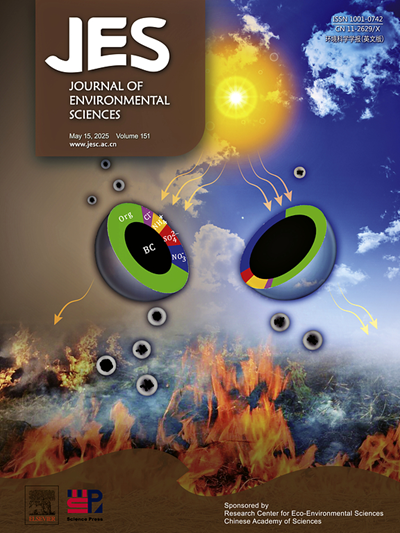Selective ozone oxidation of ammonium ion catalyzed by carbon nanocage-supported Co3O4: Role of oxygen vacancies and electron transfer sites
IF 5.9
2区 环境科学与生态学
Q1 ENVIRONMENTAL SCIENCES
引用次数: 0
Abstract
For the effective treatment of the wastewater with low-medium concentration ammonia nitrogen and low strength COD, a high-performance Co3O4 catalyst supported on carbon nanocages (CNCs) was prepared. By isovolumetric im pregnation, Co3O4 could be uniformly dispersed on surface of CNCs, which possess tiny particle size and strong electron transfer capability. The catalytic performance of the prepared Co3O4/CNCs catalysts with different Co3O4 loadings was systematically evaluated and compared with Co3O4/CNTs. It is found that 20 wt.% Co3O4/CNCs shows the best catalytic performance, achieving an ammonia nitrogen conversion rate of 71.0 % and a nitrogen selectivity of 81.8 %. Compared to commonly used Co3O4, ammonia conversion and nitrogen selectivity of Co3O4/CNCs increased by 28.9 % and 15.8 % respectively. In the five consecutive cycles, the catalytic activity remained stable. The mechanism that CNCs support effectively increases the surface oxygen vacancies of Co3O4 through XPS analysis was also elucidated, and DFT calculations confirm strong electron transfer between CNCs and Co3O4, rendering Co3O4 nanoparticles as the primary catalytic active sites. The results may contribute to the development of high-performance catalytic ozone oxidation catalysts for ammonia nitrogen.

碳纳米负载Co3O4催化铵离子选择性臭氧氧化:氧空位和电子转移位的作用
为了有效处理中低浓度氨氮和低强度COD废水,制备了一种高性能碳纳米笼负载的Co3O4催化剂。等体积浸渍法使Co3O4均匀地分散在纳米碳化硅表面,使纳米碳化硅具有微小的粒径和较强的电子传递能力。系统评价了不同Co3O4负载的Co3O4/CNTs催化剂的催化性能,并与Co3O4/CNTs进行了比较。结果表明,20wt .% Co3O4/CNCs的催化性能最好,氨氮转化率为71.0%,氮选择性为81.8%。与常用的Co3O4相比,Co3O4/ cnc的氨转化率和氮选择性分别提高了28.9%和15.8%。在连续5个循环中,催化活性保持稳定。通过XPS分析阐明了cnc载体有效增加Co3O4表面氧空位的机理,DFT计算证实了cnc与Co3O4之间的强电子转移,使得Co3O4纳米颗粒成为主要的催化活性位点。研究结果可为开发高效臭氧氧化氨氮催化剂提供参考。
本文章由计算机程序翻译,如有差异,请以英文原文为准。
求助全文
约1分钟内获得全文
求助全文
来源期刊

Journal of Environmental Sciences-china
环境科学-环境科学
CiteScore
13.70
自引率
0.00%
发文量
6354
审稿时长
2.6 months
期刊介绍:
The Journal of Environmental Sciences is an international journal started in 1989. The journal is devoted to publish original, peer-reviewed research papers on main aspects of environmental sciences, such as environmental chemistry, environmental biology, ecology, geosciences and environmental physics. Appropriate subjects include basic and applied research on atmospheric, terrestrial and aquatic environments, pollution control and abatement technology, conservation of natural resources, environmental health and toxicology. Announcements of international environmental science meetings and other recent information are also included.
 求助内容:
求助内容: 应助结果提醒方式:
应助结果提醒方式:


